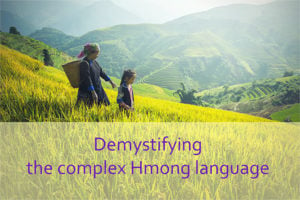Hmong—also known as Hmoob—is part of a dialect cluster called the Chuanqiandian cluster in English. Western Hmongic is also known as Chuanquandian.
There are three main dialects of Hmong:
- Hmong Daw (also called White Miao orHmong Der),
- Mong Njua (also called Blue or Green Miao orMong Leng),
- Dananshan (Standard Chinese Miao). Hmong Daw and Mong Njua are the two major dialects spoken by Hmong Americans.
White Miao is the Hmong in use in the US. It is also the basis of the written system in use here.
It’s different, here
Hmong is very different than English. Hmong is a tone language and makes use of seven (Hmong Daw and Mong Njua) or eight (Dananshan) distinct tones.
A language so special that its writing system disappeared
What if it was suddenly illegal to write? Though no one knows for sure, that’s what likely happened to Hmong speakers in the 1600s. In her book Ethnicity, Reciprocity, Reputation and Punishment: An Ethnoexperimental Study of Cooperation among the Chaldeans and Hmong of Detroit (Michigan), author Natalie Jill Smith wrote that the Qing Dynasty had caused a previous Hmong writing system to die out when it stated that the death penalty would be imposed on those who wrote it down.
Robert Cooper, an anthropologist, collected a Hmong folktale saying that the Hmong used to have a written language, and important information was written down in a treasured book. The folktale explains that cows and rats ate the book, and therefore the Hmong language was exclusively oral from that point onwards.[15]
What came next?
In the early 1950s, the now-popular Ntawv Thoob Teb (Romanized Popular Alphabet) developed by three Westerners took root. Because of its popularity in the United States it remains the most widely adopted writing system among Hmong diaspora. It is also widely used on the Internet. Our translators use this system today. There is controversy around it, though; some Hmong feel that it’s inauthentic, arguing that the consonants are distinct and should not be represented in clusters of two or three.
Go, verbs, go!
There some key differences in how verbs are used in Hmong. Let’s look at some of them.
Think one verb per sentence is all you need?
In English, that is the case. A simple sentence might be structured like this: “Mary walked up to the fence.” In Hmong, though, verbs can be serialized, or strung together—it is common to hear as many as five! Read the Hmong example:
Yam zoo tshaj plaws, nej yuav tsum mus nrhiav nug xyuas saib luag muaj kev pab hom dab tsi nyob ncig ib cheeb tsam ntawm nej.
Thing best, you (plural) must go seek, ask, examine, look others have services variations what on tour the area at you (plural)
‘The best thing you can do is to explore your neighborhood and find out what services are available.’
In Hmong, verbs do not change to reflect tense
In English and other Latin-derived languages, the verb provides information about when an event happened, or will happen. In Hmong, the when? Information is handled by adverbs such as, “today.” From Wikipedia:
Nag hmo kuv mus tom khw.
yesterday I go loc. market
‘I went to the market yesterday.’
Hmong is a beautiful language that differs from English in some fascinating ways. But don’t let its complexity scare you! ULG’s team of native-speaking Hmong translators can handle anything from marketing copy to complex legal and healthcare translation.

